There’s something about becoming a mother that makes us more conscious of the human condition. More aware. Maybe even more wary. We bring life into the world, that tiny human becomes our world, and we are hit with an instinctive need to protect them from the world.
My transformation to mum has been no different. In fact, now a mother of three, it was this metamorphosis that led me to launch my organic baby skincare range with the aim of taking the worry out of bath time for me and my fellow mamas.
Choosing baby skincare products (and personal care products for ourselves) shouldn’t be challenging. But, sadly, with ‘greenwashing’ happening a lot more than it should, it’s not so straightforward.
Before my eldest son, Oliver, was born in 2011 I went out and bought a range of baby care products to have ready in his nursery. They were mostly products I’d picked off the shelves of baby outlets, but sold with the notion of being safe and natural.
After Oliver was born I started using these products on his newborn skin and was shocked to find he reacted to a number of them. His skin became red and flaky, but rather than dismiss it as a normal reaction to being out in the world, I started scrutinising the ingredient labels on the products I’d chosen.
This was a game-changer for our family. I quickly discovered that some ‘natural’ products on the market contain potentially harmful ingredients. And the products I was using on Oliver were just the tip of the iceberg – diving into our bathroom cupboard I found a number of hidden nasties with the potential to harm my little one.
According to the Environmental Working Group (EWG), our children are being exposed to an unacceptable number of chemicals via personal care products. One survey found that body products are responsible for exposing children to an average of 60 chemicals every day, some of which have never been assessed for their toxicity on a little person’s body.



Top Comments
My favourite product is QV. My children and my entire extended family use it.